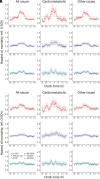Brighter nights and darker days predict higher mortality risk: A prospective analysis of personal light exposure in >88,000 individuals
- PMID: 39405349
- PMCID: PMC11513964
- DOI: 10.1073/pnas.2405924121
Brighter nights and darker days predict higher mortality risk: A prospective analysis of personal light exposure in >88,000 individuals
Abstract
Light enhances or disrupts circadian rhythms, depending on the timing of exposure. Circadian disruption contributes to poor health outcomes that increase mortality risk. Whether personal light exposure predicts mortality risk has not been established. We therefore investigated whether personal day and night light, and light patterns that disrupt circadian rhythms, predicted mortality risk. UK Biobank participants (N = 88,905, 62.4 ± 7.8 y, 57% female) wore light sensors for 1 wk. Day and night light exposures were defined by factor analysis of 24-h light profiles. A computational model of the human circadian pacemaker was applied to model circadian amplitude and phase from light data. Cause-specific mortality was recorded in 3,750 participants across a mean (±SD) follow-up period of 8.0 ± 1.0 y. Individuals with brighter day light had incrementally lower all-cause mortality risk (adjusted-HR ranges: 0.84 to 0.90 [50 to 70th light exposure percentiles], 0.74 to 0.84 [70 to 90th], and 0.66 to 0.83 [90 to 100th]), and those with brighter night light had incrementally higher all-cause mortality risk (aHR ranges: 1.15 to 1.18 [70 to 90th], and 1.21 to 1.34 [90 to 100th]), compared to individuals in darker environments (0 to 50th percentiles). Individuals with lower circadian amplitude (aHR range: 0.90 to 0.96 per SD), earlier circadian phase (aHR range: 1.16 to 1.30), or later circadian phase (aHR range: 1.13 to 1.20) had higher all-cause mortality risks. Day light, night light, and circadian amplitude predicted cardiometabolic mortality, with larger hazard ratios than for mortality by other causes. Findings were robust to adjustment for age, sex, ethnicity, photoperiod, and sociodemographic and lifestyle factors. Minimizing night light, maximizing day light, and keeping regular light-dark patterns that enhance circadian rhythms may promote cardiometabolic health and longevity.
Keywords: cardiometabolic; circadian disruption; light at night; light sensor; longevity.
Conflict of interest statement
Competing interests statement:S.W.C. has consulted for Dyson. A.J.K.P. and S.W.C. are co-founders and co-directors of Circadian Health Innovations PTY LTD. A.J.K.P. and S.W.C. have received research funding from Versalux and Delos. S.W.C. has received research funding from Beacon Lighting. P.O. co-founded Axivity Ltd, and was a director until 2015.
Figures

References
-
- Zelinski E. L., Deibel S. H., McDonald R. J., The trouble with circadian clock dysfunction: Multiple deleterious effects on the brain and body. Neurosci. Biobehav. Rev. 40, 80–101 (2014). - PubMed
-
- Jewett M. E., Kronauer R. E., Czeisler C. A., Phase-amplitude resetting of the human circadian pacemaker via bright light: A further analysis. J. Biol. Rhythms 9, 295–314 (1994). - PubMed
MeSH terms
Grants and funding
LinkOut - more resources
Full Text Sources

